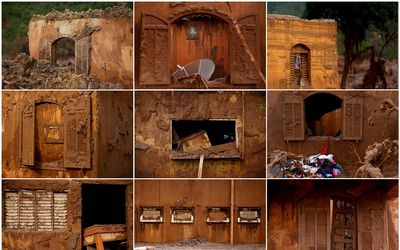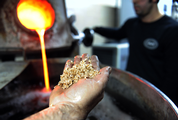Locals want Brazil’s Samarco mine to restart production
by Marta Nogueira,
2016-03-16 05:52:12.0
IN NOVEMBER, Marcos de Freitas lost his home and everything he owned when a dam burst at a nearby mine released a flow of mud that buried his village, Bento Rodrigues.
Now, sitting in a house paid for by the company responsible, he wants the mine to reopen.
"I have nothing to complain about," says the 55-year-old retired miner. "Samarco has to start producing again in order to create jobs," he said.
Samarco, which is owned jointly by Vale and BHP Billiton, is the mine operator. The flood of mining waste, known as tailings, killed 19 people, left about 800 homeless and polluted a major river, in what the government called Brazil’s worst environmental disaster yet.
Mr Freitas’s view is widely held in Mariana, just 25km from the mine.
The historic town of 60,000 people, built on gold mining during the Portuguese colonial era, relies on the red iron ore in the surrounding hills for nearly 90% of its revenue.
Since the mine closed four months ago, the line at the unemployment agency has lengthened steadily, as those looking for jobs surged from 300 to 1,900. It could grow longer still if Samarco starts to lay off its 3,000 direct employees.
On Saturday, about a thousand people marched through the town centre’s cobbled streets demanding the pit reopen. "Justice yes, unemployment no!" they shouted. Mayor Duarte Junior worries that government agencies are dragging their feet because of the high profile of the disaster.
"If Samarco does not reopen, we will start to have a problem. We are reaching our limit," Mr Junior said in his office in City Hall.
"I ask the bodies responsible to analyse Samarco’s case as a priority."
The company needs permission from the state’s environmental agency, Semad, and federal mining regulator DNPM.
Geraldo Abreu, head of environmental regulation at Semad, admits were it not for the spill, a licence to restart would be simple. He says no corners would be cut, even though the application may be given priority:
"Imagine if we jumped a stage and there was another accident."
Rising calls for a restart make many nervous. Prosecutors blame the spill partially on lax regulation and a decentralised licensing system that was too easily influenced by economic heft. They worry nothing has changed.
"Money is speaking loudest," says Antonio Carlos de Oliveira, a state prosecutor in Mariana and part of the task force set up to bring an environmental case against Samarco. "There’s no way to ensure the minimum conditions of security are respected or that the environmental bodies will make proper supervision."
The cause of the disaster remains unknown. An investigation is not expected to publish findings until mid-year, but Samarco says it can restart reduced production without constructing a new tailings dam, and do so without risk of another disaster.
"We do not work with the scenario that the mine will not reopen," Samarco CEO Roberto Carvalho said in a recent interview.
He expects Samarco to restart by October at an annual rate of 19-million tonnes of iron ore pellets, down sharply from 30-million tonnes before the spill. Tailings will be stored in old pits without need to build a new dam. The company can run at this reduced rate for about two years before a longer-term solution for the tailings is needed. At that stage, things could become more complicated.
The International Council on Mining and Metals, an association of more than 20 mining companies, is looking into tailings management following the Samarco disaster, but said it was too early to discuss its findings.
Mr Carvalho said Samarco was considering options for its tailings, but would await the investigation before deciding. The mine has enough ore to run for another 50 years.
Back in Mariana, 27-year-old Genivaldo Nascimento waits for the job centre to open. A mechanic, he was laid off recently by a Samarco supplier. "I have never been unemployed before. I am desperate. I have two children to look after," he said.
He feels the authorities are to blame for not letting Samarco restart. "I’m angry because they are damaging Samarco."
Reuters

DEVASTATION: Houses in Bento Rodrigues district after the dam burst at Samarco mine. Affected villagers have been rehoused by Samarco, but the line at the unemployment agency has grown since the mine shut down. Picture: REUTERS/RICARDO MORAS
IN NOVEMBER, Marcos de Freitas lost his home and everything he owned when a dam burst at a nearby mine released a flow of mud that buried his village, Bento Rodrigues.
Now, sitting in a house paid for by the company responsible, he wants the mine to reopen.
"I have nothing to complain about," says the 55-year-old retired miner. "Samarco has to start producing again in order to create jobs," he said.
Samarco, which is owned jointly by Vale and BHP Billiton, is the mine operator. The flood of mining waste, known as tailings, killed 19 people, left about 800 homeless and polluted a major river, in what the government called Brazil’s worst environmental disaster yet.
Mr Freitas’s view is widely held in Mariana, just 25km from the mine.
The historic town of 60,000 people, built on gold mining during the Portuguese colonial era, relies on the red iron ore in the surrounding hills for nearly 90% of its revenue.
Since the mine closed four months ago, the line at the unemployment agency has lengthened steadily, as those looking for jobs surged from 300 to 1,900. It could grow longer still if Samarco starts to lay off its 3,000 direct employees.
On Saturday, about a thousand people marched through the town centre’s cobbled streets demanding the pit reopen. "Justice yes, unemployment no!" they shouted. Mayor Duarte Junior worries that government agencies are dragging their feet because of the high profile of the disaster.
"If Samarco does not reopen, we will start to have a problem. We are reaching our limit," Mr Junior said in his office in City Hall.
"I ask the bodies responsible to analyse Samarco’s case as a priority."
The company needs permission from the state’s environmental agency, Semad, and federal mining regulator DNPM.
Geraldo Abreu, head of environmental regulation at Semad, admits were it not for the spill, a licence to restart would be simple. He says no corners would be cut, even though the application may be given priority:
"Imagine if we jumped a stage and there was another accident."
Rising calls for a restart make many nervous. Prosecutors blame the spill partially on lax regulation and a decentralised licensing system that was too easily influenced by economic heft. They worry nothing has changed.
"Money is speaking loudest," says Antonio Carlos de Oliveira, a state prosecutor in Mariana and part of the task force set up to bring an environmental case against Samarco. "There’s no way to ensure the minimum conditions of security are respected or that the environmental bodies will make proper supervision."
The cause of the disaster remains unknown. An investigation is not expected to publish findings until mid-year, but Samarco says it can restart reduced production without constructing a new tailings dam, and do so without risk of another disaster.
"We do not work with the scenario that the mine will not reopen," Samarco CEO Roberto Carvalho said in a recent interview.
He expects Samarco to restart by October at an annual rate of 19-million tonnes of iron ore pellets, down sharply from 30-million tonnes before the spill. Tailings will be stored in old pits without need to build a new dam. The company can run at this reduced rate for about two years before a longer-term solution for the tailings is needed. At that stage, things could become more complicated.
The International Council on Mining and Metals, an association of more than 20 mining companies, is looking into tailings management following the Samarco disaster, but said it was too early to discuss its findings.
Mr Carvalho said Samarco was considering options for its tailings, but would await the investigation before deciding. The mine has enough ore to run for another 50 years.
Back in Mariana, 27-year-old Genivaldo Nascimento waits for the job centre to open. A mechanic, he was laid off recently by a Samarco supplier. "I have never been unemployed before. I am desperate. I have two children to look after," he said.
He feels the authorities are to blame for not letting Samarco restart. "I’m angry because they are damaging Samarco."
Reuters





















Change: 1.19%
Change: 1.36%
Change: 2.19%
Change: 1.49%
Change: -0.77%
Data supplied by Profile Data
Change: -0.19%
Change: 0.69%
Change: 1.19%
Change: 0.00%
Change: 0.44%
Data supplied by Profile Data
Change: 0.62%
Change: 0.61%
Change: 0.23%
Change: 0.52%
Change: 0.12%
Data supplied by Profile Data
Change: -0.21%
Change: -1.22%
Change: -0.69%
Change: -0.51%
Change: 0.07%
Data supplied by Profile Data